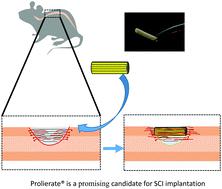当前位置:
X-MOL 学术
›
Biomater. Sci.
›
论文详情
Our official English website, www.x-mol.net, welcomes your feedback! (Note: you will need to create a separate account there.)
A novel poly-ε-lysine based implant, Proliferate®, for promotion of CNS repair following spinal cord injury.
Biomaterials Science ( IF 6.6 ) Pub Date : 2020-06-03 , DOI: 10.1039/d0bm00097c Sara Hosseinzadeh 1 , Susan L Lindsay , Andrew G Gallagher , Donald A Wellings , Mathis O Riehle , John S Riddell , Susan C Barnett
Biomaterials Science ( IF 6.6 ) Pub Date : 2020-06-03 , DOI: 10.1039/d0bm00097c Sara Hosseinzadeh 1 , Susan L Lindsay , Andrew G Gallagher , Donald A Wellings , Mathis O Riehle , John S Riddell , Susan C Barnett
Affiliation

|
The limited regenerative capacity of the CNS poses formidable challenges to the repair of spinal cord injury (SCI). Two key barriers to repair are (i) the physical gap left by the injury, and (ii) the inhibitory milieu surrounding the injury, the glial scar. Biomaterial implantation into the injury site can fill the cavity, provide a substrate for cell migration, and potentially attenuate the glial scar. We investigated the biological viability of a biocompatible and biodegradable poly-ε-lysine based biomaterial, Proliferate®, in low and high cross-linked forms and when coated with IKVAV peptide, for SCI implantation. We demonstrate altered astrocyte morphology and nestin expression on Proliferate® compared to conventional glass cell coverslips suggesting a less reactive phenotype. Moreover Proliferate® supported myelination in vitro, with myelination observed sooner on IKVAV-coated constructs compared with uncoated Proliferate®, and delayed overall compared with maintenance on glass coverslips. For in vivo implantation, parallel-aligned channels were fabricated into Proliferate® to provide cell guidance cues. Extensive vascularisation and cellular infiltration were observed in constructs implanted in vivo, along with an astrocyte border and microglial response. Axonal ingrowth was observed at the construct border and inside implants in intact channels. We conclude that Proliferate® is a promising biomaterial for implantation following SCI.
中文翻译:

一种新型的基于聚ε-赖氨酸的植入物Proliferate®,用于促进脊髓损伤后中枢神经系统的修复。
中枢神经系统有限的再生能力对修复脊髓损伤(SCI)提出了巨大的挑战。修复的两个主要障碍是(i)损伤留下的物理间隙,以及(ii)损伤周围的抑制性环境,神经胶质瘢痕。将生物材料植入损伤部位可以填充空腔,为细胞迁移提供基质,并可能减轻神经胶质瘢痕。我们研究了以生物相容性和可生物降解的聚ε-赖氨酸为基础的生物材料Proliferate®的生物生存能力,该材料具有低交联形式和高交联形式,并用IKVAV肽包被时可用于SCI植入。与传统的玻璃细胞盖玻片相比,我们证明了Proliferate®上星形胶质细胞形态和巢蛋白表达的改变,表明其反应性较低。此外,Proliferate®支持的髓鞘形成在体外,与未涂层的Proliferate®相比,在IKVAV涂层的构建体上观察到的髓鞘形成要早,与玻璃盖玻片的维护相比,总体延迟。对于体内植入,将平行对齐的通道制成Proliferate®,以提供细胞引导提示。在体内植入的结构中观察到广泛的血管形成和细胞浸润,以及星形胶质细胞边界和小胶质细胞反应。在完整的通道中,在构建体边界和植入物内部观察到轴突向内生长。我们得出的结论是,Proliferate®是有希望的SCI植入生物材料。
更新日期:2020-06-30
中文翻译:

一种新型的基于聚ε-赖氨酸的植入物Proliferate®,用于促进脊髓损伤后中枢神经系统的修复。
中枢神经系统有限的再生能力对修复脊髓损伤(SCI)提出了巨大的挑战。修复的两个主要障碍是(i)损伤留下的物理间隙,以及(ii)损伤周围的抑制性环境,神经胶质瘢痕。将生物材料植入损伤部位可以填充空腔,为细胞迁移提供基质,并可能减轻神经胶质瘢痕。我们研究了以生物相容性和可生物降解的聚ε-赖氨酸为基础的生物材料Proliferate®的生物生存能力,该材料具有低交联形式和高交联形式,并用IKVAV肽包被时可用于SCI植入。与传统的玻璃细胞盖玻片相比,我们证明了Proliferate®上星形胶质细胞形态和巢蛋白表达的改变,表明其反应性较低。此外,Proliferate®支持的髓鞘形成在体外,与未涂层的Proliferate®相比,在IKVAV涂层的构建体上观察到的髓鞘形成要早,与玻璃盖玻片的维护相比,总体延迟。对于体内植入,将平行对齐的通道制成Proliferate®,以提供细胞引导提示。在体内植入的结构中观察到广泛的血管形成和细胞浸润,以及星形胶质细胞边界和小胶质细胞反应。在完整的通道中,在构建体边界和植入物内部观察到轴突向内生长。我们得出的结论是,Proliferate®是有希望的SCI植入生物材料。


























 京公网安备 11010802027423号
京公网安备 11010802027423号